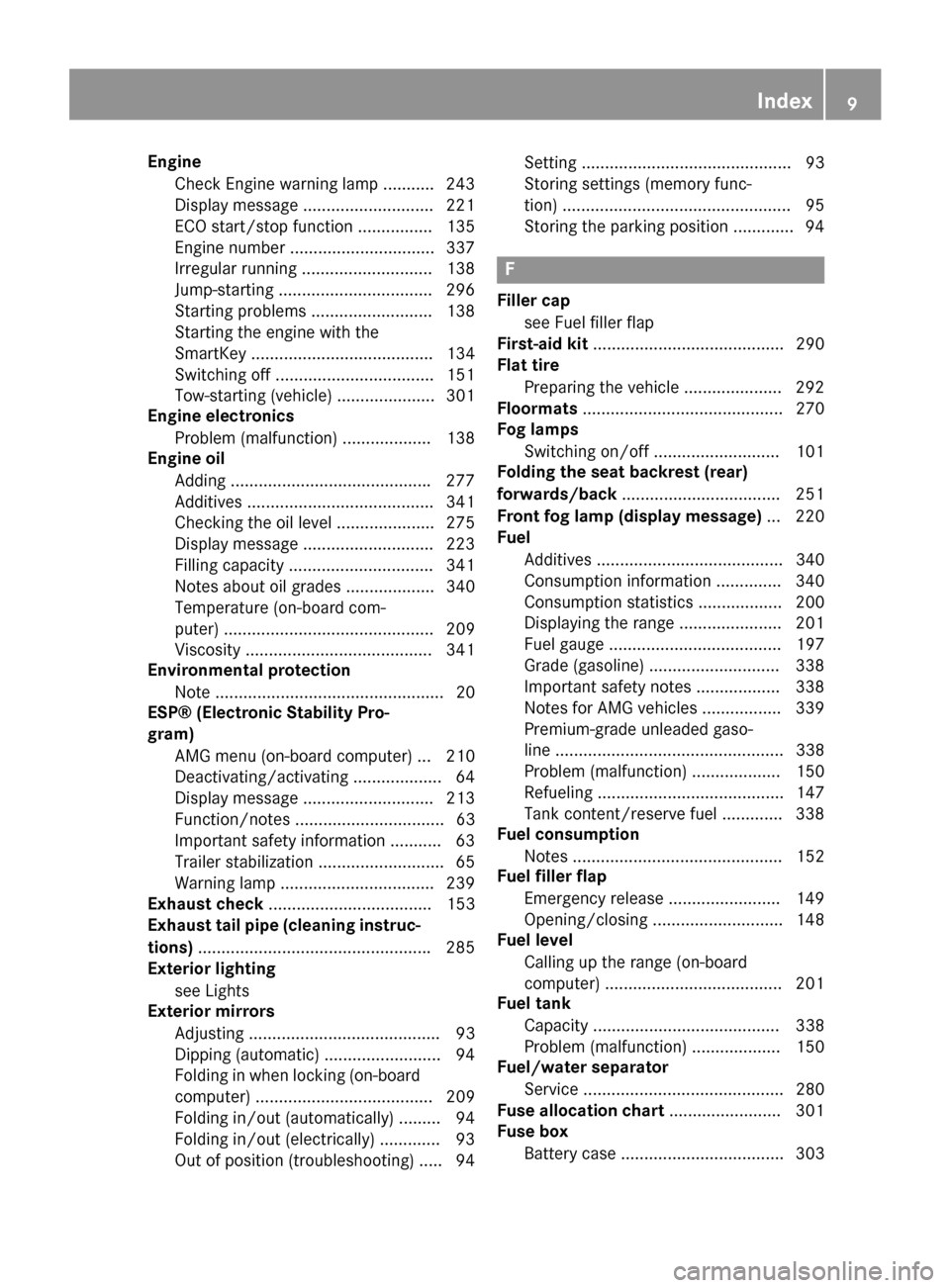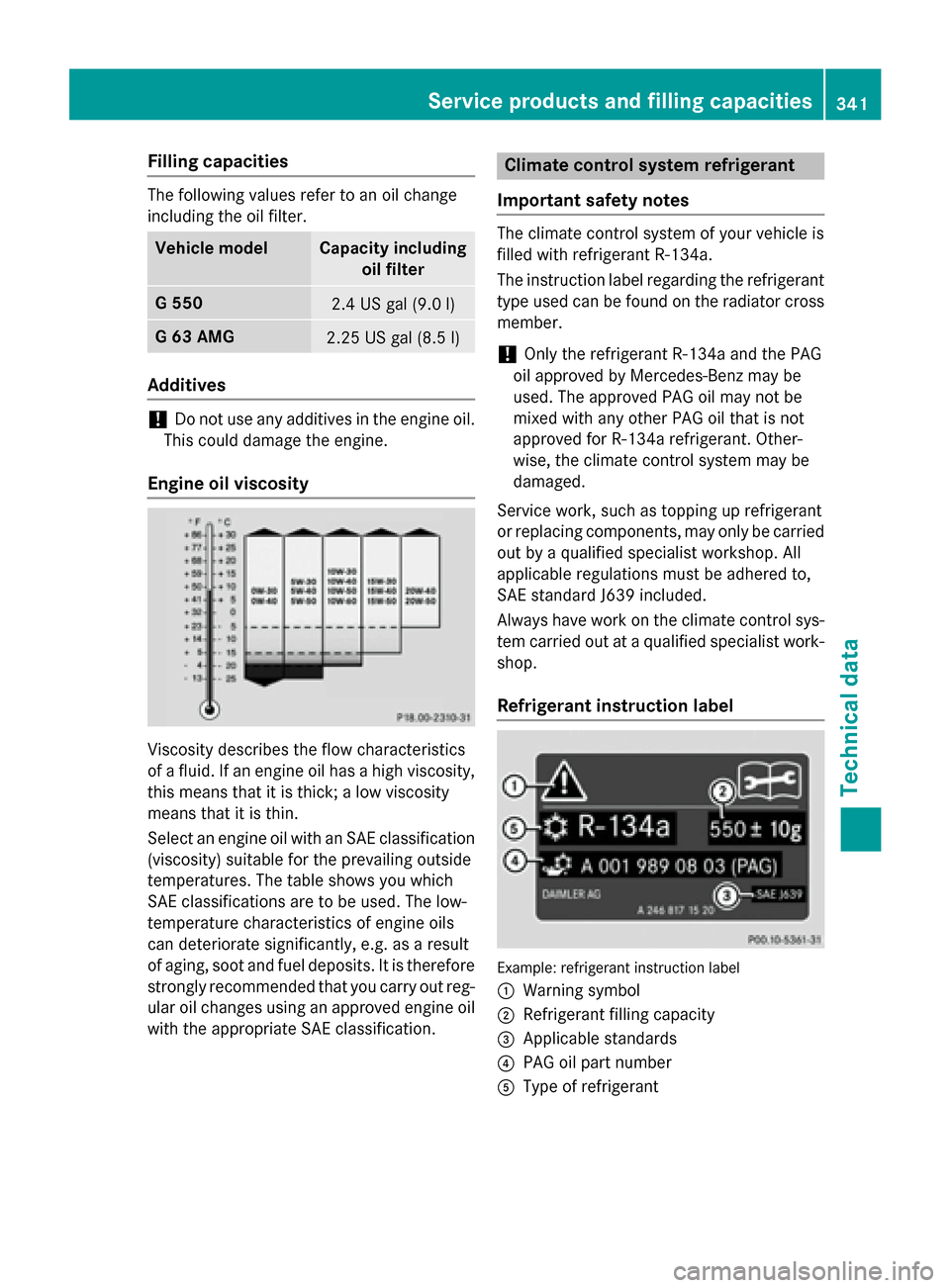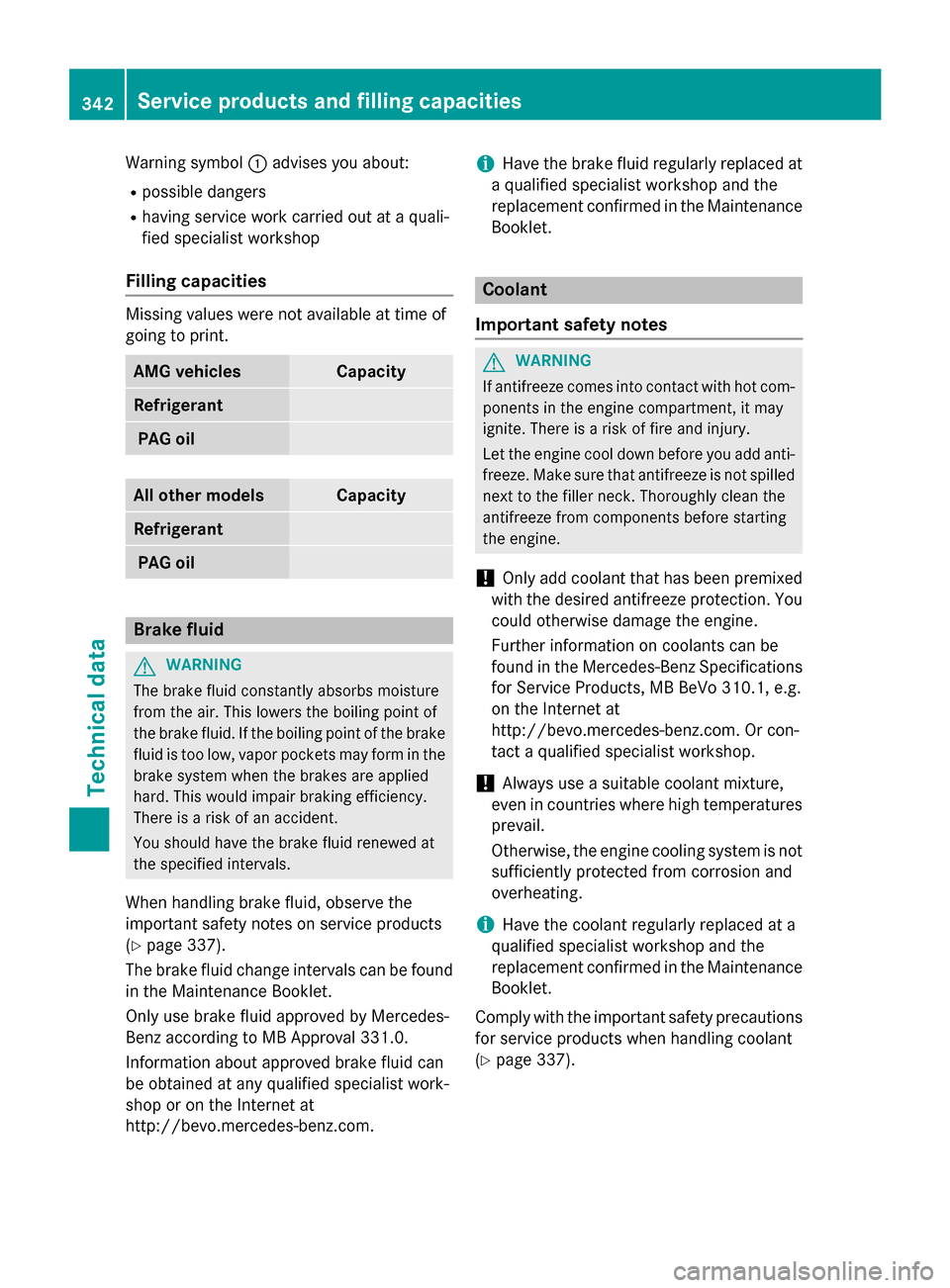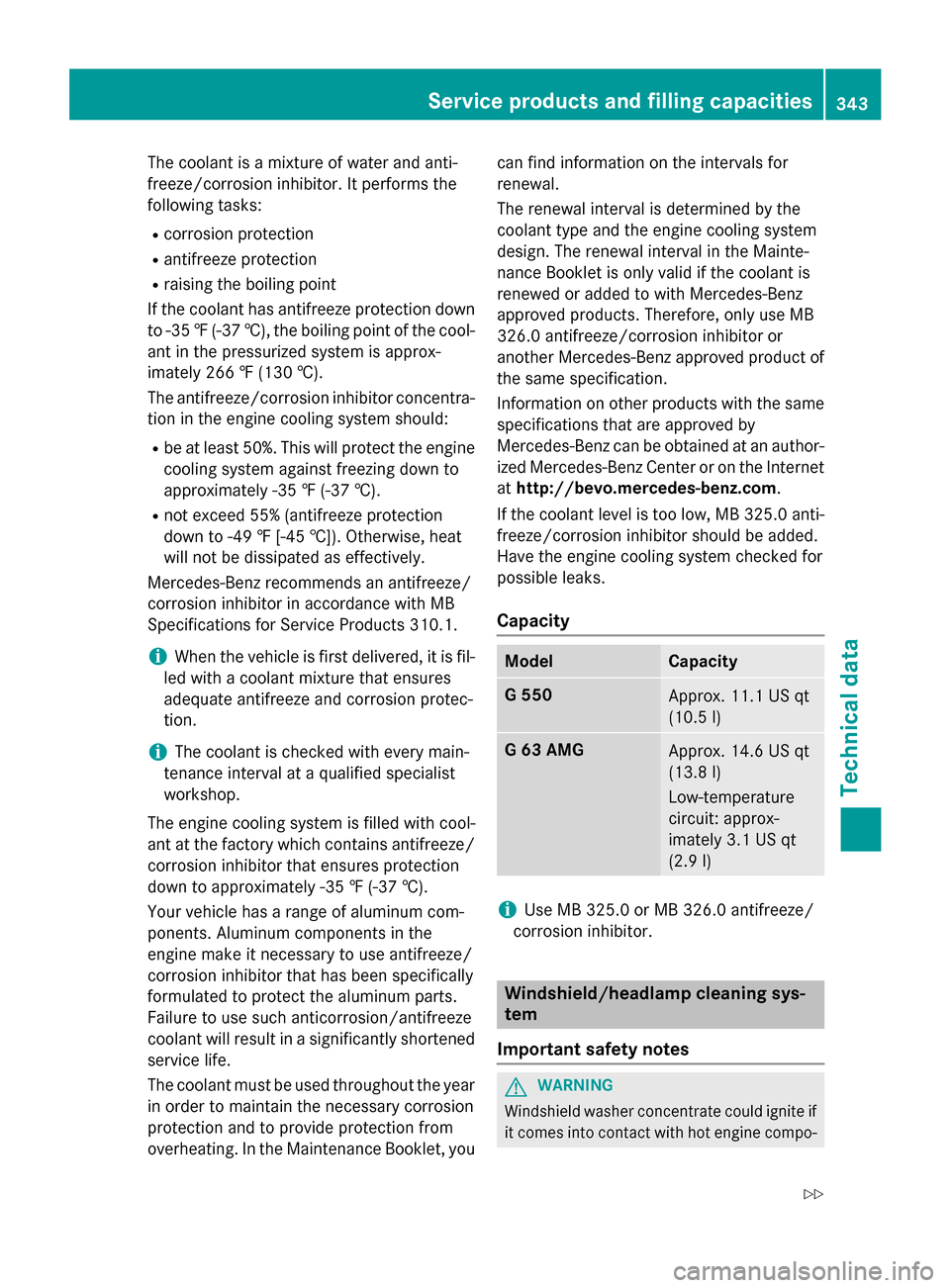oil capacity MERCEDES-BENZ G-Class 2015 W463 Owner's Manual
[x] Cancel search | Manufacturer: MERCEDES-BENZ, Model Year: 2015, Model line: G-Class, Model: MERCEDES-BENZ G-Class 2015 W463Pages: 350, PDF Size: 6.44 MB
Page 11 of 350

Engine
Check Engine warning lamp .......... .243
Display message ............................ 221
ECO start/stop function ................ 135
Engine number ............................... 337
Irregular running ............................ 138
Jump-starting ................................. 296
Starting problems .......................... 138
Starting the engine with the
SmartKey ....................................... 134
Switching off .................................. 151
Tow-starting (vehicle) ..................... 301
Engine electronics
Problem (malfunction) ................... 138
Engine oil
Adding .......................................... .277
Additives ........................................ 341
Checking the oil level ..................... 275
Display message ............................ 223
Filling capacity ............................... 341
Notes about oil grades ................... 340
Temperature (on-board com-
puter) ............................................. 209
Viscosity ........................................ 341
Environmental protection
Note ................................................. 20
ESP® (Electronic Stability Pro-
gram)
AMG menu (on-board computer) ... 210
Deactivating/activating ................... 64
Display message ............................ 213
Function/notes ................................ 63
Important safety information ........... 63
Trailer stabilization ........................... 65
Warning lamp ................................. 239
Exhaust check ................................... 153
Exhaust tail pipe (cleaning instruc-
tions) ................................................. .285
Exterior lighting
see Lights
Exterior mirrors
Adjusting ......................................... 93
Dipping (automatic) ......................... 94
Folding in when locking (on-board
computer) ...................................... 209
Folding in/out (automatically) ......... 94
Folding in/out (electrically) ............. 93
Out of position (troubleshooting) ..... 94 Setting ............................................. 93
Storing settings (memory func-
tion) ................................................. 95
Storing the parking position ............. 94 F
Filler cap see Fuel filler flap
First-aid kit ......................................... 290
Flat tire
Preparing the vehicle ..................... 292
Floormats ........................................... 270
Fog lamps
Switching on/of f........................... 101
Folding the seat backrest (rear)
forwards/back .................................. 251
Front fog lamp (display message) ... 220
Fuel
Additives ........................................ 340
Consumption information .............. 340
Consumption statistics .................. 200
Displaying the range ...................... 201
Fuel gaug e..................................... 197
Grade (gasoline )............................ 338
Important safety notes .................. 338
Notes for AMG vehicles ................. 339
Premium-grade unleaded gaso-
line ................................................. 338
Problem (malfunction) ................... 150
Refueling ........................................ 147
Tank content/reserve fue l............. 338
Fuel consumption
Notes ............................................. 152
Fuel filler flap
Emergency release ........................ 149
Opening/closing ............................ 148
Fuel level
Calling up the range (on-board
computer) ...................................... 201
Fuel tank
Capacity ........................................ 338
Problem (malfunction) ................... 150
Fuel/water separator
Service ........................................... 280
Fuse allocation chart ........................ 301
Fuse box
Battery case ................................... 303 Index
9
Page 328 of 350

Maximum loaded vehicle weight
The maximum weight is the sum of:
R
the curb weight of the vehicle
R the weight of the accessories
R the load limit
R the weight of the factory installed optional
equipment
Kilopascal (kPa) Metric unit for tire pressure. 6.9 kPa corre-
sponds to 1 psi. Another unit for tire pressure
is bar. 100 kilopascals (kPa) are the equiva-
lent of 1 bar.
Load index In addition to the load-bearing index, the load
index may also be imprinted on the sidewall of
the tire. This specifies the load-bearing capa- city more precisely.
Curb weight The weight of a vehicle with standard equip-
ment including the maximum capacity of fuel,
oil and coolant. It also includes the air-condi- tioning system and optional equipment if
these are installed in the vehicle, but does notinclude passengers or luggage.
Maximum load rating The maximum load rating is the maximum
permissible weight in kilograms or lbs for
which a tire is approved.
Maximum permissible tire pressure Maximum permissible tire pressure for one
tire.
Maximum load on one tire Maximum load on one tire. This is calculated
by dividing the maximum axle load of one axle
by two. PSI (pounds per square inch) A standard unit of measure for tire pressure.
Aspect ratio Relationship between tire height and tire
width in percent.
Tire pressure This is pressure inside the tire applying an
outward force to each square inch of the tire's surface. The tire pressure is specified in
pounds per square inch (psi), in kilopascals
(kPa) or in bar. The tire pressure should only
be corrected when the tires are cold.
Cold tire pressure The tires are cold:
R if the vehicle has been parked without
direct sunlight on the tires for at least three
hours and
R if the vehicle has not been driven further
than 1 mile (1.6 km)
Tread The part of the tire that comes into contact
with the road.
Bead The tire bead ensures that the tire sits
securely on the wheel. There are several steel
wires in the bead to prevent the tire from
coming loose from the wheel rim.
Sidewall The part of the tire between the tread and the
bead.
Weight of optional extras The combined weight of those optional extras
that weigh more than the replaced standard
parts and more than 2.3 kg (5 lbs). These
optional extras, such as high-performance 326
Tire labelingWheels and tires
Page 343 of 350

Filling capacities
The following values refer to an oil change
including the oil filter. Vehicle model Capacity including
oil filter G 550
2.4 US gal (9.0 l)
G 63 AMG
2.25 US gal (8.5 l)
Additives
!
Do not use any additives in the engine oil.
This could damage the engine.
Engine oil viscosity Viscosity describes the flow characteristics
of a fluid. If an engine oil has a high viscosity, this means that it is thick; a low viscosity
means that it is thin.
Select an engine oil with an SAE classification (viscosity) suitable for the prevailing outside
temperatures. The table shows you which
SAE classifications are to be used. The low-
temperature characteristics of engine oils
can deteriorate significantly, e.g. as a result
of aging, soot and fuel deposits. It is therefore
strongly recommended that you carry out reg- ular oil changes using an approved engine oil
with the appropriate SAE classification. Climate control system refrigerant
Important safety notes The climate control system of your vehicle is
filled with refrigerant R‑
134a.
The instruction label regarding the refrigerant type used can be found on the radiator cross
member.
! Only the refrigerant R‑134a and the PAG
oil approved by Mercedes-Benz may be
used. The approved PAG oil may not be
mixed with any other PAG oil that is not
approved for R-134a refrigerant. Other-
wise, the climate control system may be
damaged.
Service work, such as topping up refrigerant
or replacing components, may only be carried out by a qualified specialist workshop. All
applicable regulations must be adhered to,
SAE standard J639 included.
Always have work on the climate control sys-
tem carried out at a qualified specialist work-
shop.
Refrigerant instruction label Example: refrigerant instruction label
:
Warning symbol
; Refrigerant filling capacity
= Applicable standards
? PAG oil part number
A Type of refrigerant Service products and filling capacities
341Technical data Z
Page 344 of 350

Warning symbol
:advises you about:
R possible dangers
R having service work carried out at a quali-
fied specialist workshop
Filling capacities Missing values were not available at time of
going to print. AMG vehicles Capacity
Refrigerant
PAG oil
All other models Capacity
Refrigerant
PAG oil
Brake fluid
G
WARNING
The brake fluid constantly absorbs moisture
from the air. This lowers the boiling point of
the brake fluid. If the boiling point of the brake fluid is too low, vapor pockets may form in the brake system when the brakes are applied
hard. This would impair braking efficiency.
There is a risk of an accident.
You should have the brake fluid renewed at
the specified intervals.
When handling brake fluid, observe the
important safety notes on service products
(Y page 337).
The brake fluid change intervals can be found
in the Maintenance Booklet.
Only use brake fluid approved by Mercedes-
Benz according to MB Approval 331.0.
Information about approved brake fluid can
be obtained at any qualified specialist work-
shop or on the Internet at
http://bevo.mercedes-benz.com. i
Have the brake fluid regularly replaced at
a qualified specialist workshop and the
replacement confirmed in the Maintenance Booklet. Coolant
Important safety notes G
WARNING
If antifreeze comes into contact with hot com- ponents in the engine compartment, it may
ignite. There is a risk of fire and injury.
Let the engine cool down before you add anti-
freeze. Make sure that antifreeze is not spilled
next to the filler neck. Thoroughly clean the
antifreeze from components before starting
the engine.
! Only add coolant that has been premixed
with the desired antifreeze protection. You
could otherwise damage the engine.
Further information on coolants can be
found in the Mercedes-Benz Specifications for Service Products, MB BeVo 310.1, e.g.
on the Internet at
http://bevo.mercedes-benz.com. Or con-
tact a qualified specialist workshop.
! Always use a suitable coolant mixture,
even in countries where high temperatures prevail.
Otherwise, the engine cooling system is not
sufficiently protected from corrosion and
overheating.
i Have the coolant regularly replaced at a
qualified specialist workshop and the
replacement confirmed in the Maintenance Booklet.
Comply with the important safety precautions for service products when handling coolant
(Y page 337). 342
Service products and filling capacitiesTechnical data
Page 345 of 350

The coolant is a mixture of water and anti-
freeze/corrosion inhibitor. It performs the
following tasks:
R corrosion protection
R antifreeze protection
R raising the boiling point
If the coolant has antifreeze protection down to -35 ‡(-37 †), the boiling point of the cool-
ant in the pressurized system is approx-
imately 266 ‡ (130 †).
The antifreeze/corrosion inhibitor concentra- tion in the engine cooling system should:
R be at least 50%. This will protect the engine
cooling system against freezing down to
approximately -35 ‡ (-37 †).
R no t exceed 55% (antifreeze protection
down to -49 ‡ [-45 †]). Otherwise, heat
will no t be dissipated as effectively.
Mercedes-Benz recommends an antifreeze/
corrosion inhibitor in accordance with MB
Specifications for Service Products 310.1.
i When the vehicle is first delivered, it is fil-
led with a coolant mixture that ensures
adequate antifreeze and corrosion protec-
tion.
i The coolant is checked with every main-
tenance interval at a qualified specialist
workshop.
The engine cooling system is filled with cool-
ant at the factory which contains antifreeze/
corrosion inhibitor that ensures protection
down to approximately -35 ‡ (-37 †).
Your vehicle has a range of aluminum com-
ponen ts. Aluminum components in the
engine make it necessary to use antifreeze/
corrosion inhibitor that has been specifically
formulated to protect the aluminum parts.
Failure to use such anticorrosion/antifreeze
coolant will result in a significantly shortened
service life.
The coolant must be used throughout the year
in order to maintain the necessary corrosion
protection and to provide protection from
overheating. In the Maintenance Booklet, you can find information on the intervals for
renewal.
The renewal interval is determined by the
coolant type and the engine cooling system
design. The renewal interval in the Mainte-
nance Booklet is only valid if the coolant is
renewed or added to with Mercedes-Benz
approved products. Therefore, only use MB
326.0 antifreeze/corrosion inhibitor or
another Mercedes-Benz approved product of the same specification.
Information on other products with the same
specifications that are approved by
Mercedes-Benz can be obtained at an author- ized Mercedes-Benz Center or on the Internet at http://bevo.mercedes-benz.com.
If the coolant level is too low, MB 325.0 anti-
freeze/corrosion inhibitor should be added.
Have the engine cooling system checked for
possible leaks.
Capacity Model Capacity
G 550
Approx. 11.1 US qt
(10.5 l)
G 63 AMG
Approx. 14.6 US qt
(13.8 l)
Low-temperature
circuit: approx-
imately 3.1 US qt
(2.9 l)
i
Use MB 325.0 or MB 326.0 antifreeze/
corrosion inhibitor. Windshield/headlamp cleaning sys-
tem
Important safety notes G
WARNING
Windshield washer concentrate could ignite if it comes into contact with hot engine compo- Service products and filling capacities
343Technical data
Z